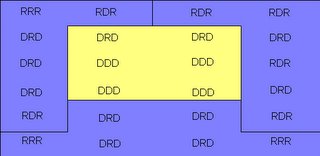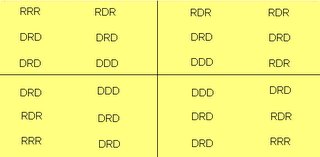The Gerrymandering "Game"
In the testimony heard by the Pierce County Charter Review Commission thus far, some have expressed dissatisfaction with the Districting Committee process. The problem is with the task being given to the Districting Committee, not the particular process being used. Some people have recommended a process which sounds like the "cracking" methodology described below. As shown below, so long as we have single member districts, there will be political implications of either "packing" or "cracking". To effectively reduce the political implications of the Districting process, the County would have to shift from our current set of Districts for electing County Council members.
The material below is based on a section of Real Choice, New Voices by Douglas Amy. For people in interested in more detail about multi-member districts, this book is recommended.
Our current election system guarantees that there will be minorities in every district who remain unrepresented by someone with their political views. District lines can be drawn either to shut out minority voices or strengthen them — A process called "gerrymandering." As this game illustrates, the way in which district lines are drawn has a great effect on who wins representation in Single-Member District, Winner-Take-All elections.
Below is a map of the political geography of a typical city. There are 40 Democrats (D) concentrated in the center and 32 Republicans (R) dominating the suburbs. Our current winner-take-all election system divides such areas up into districts, each represented by a single elected official. The city pictured must be divided into four districts, each with six "neighborhoods" (a cluster of three letters).

First, imagine how to draw district lines to create a district plan which gives Republicans a strong advantage over Democrats. (Hint: The tactic known as "packing," in which strongly partisan areas are packed into a single district, should be used here.)
Next, create a district plan where the Democrats have the advantage. (Hint: "Crack" the Republicans among several districts.)
When you think you have it figured out, check out the solutions below.
Here are the solutions to the "Gerrymandering Game." In the upper map, you can see how district lines are drawn to "pack" most of the Democratic voters into a central district. Thus, on election day, one Democrat and three Republicans are likely to be elected. In a city that is 56 percent Democrat and 44 percent Republican, these districts would give the majority party only 25 percent of the seats, while the minority party would get three out of four seats.
In the second map, you can see how district lines divide Republican supporters evenly among the four districts. Thus, though a sizeable minority in the city (44 percent), they will probably see no Republicans elected. Democratic voters with a small numerical majority will get all the representation.

 Of course, politicians know that Gerrymandering is more than a mere game. Every ten years, after the census, the redistricting process begins anew, and each time, parties who play a role in the districting process work to create "safe districts" for their candidates. This problem cannot be avoided using Single-Member Districts and Winner-Take-All voting — only elections using Multi-Member Proportional Districts can eliminate the problem of Gerrymandering and assure election results that accurately reflect the views of voters.
Of course, politicians know that Gerrymandering is more than a mere game. Every ten years, after the census, the redistricting process begins anew, and each time, parties who play a role in the districting process work to create "safe districts" for their candidates. This problem cannot be avoided using Single-Member Districts and Winner-Take-All voting — only elections using Multi-Member Proportional Districts can eliminate the problem of Gerrymandering and assure election results that accurately reflect the views of voters.


0 Comments:
Post a Comment
<< Home